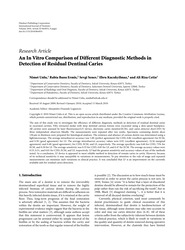An In Vitro Comparison of Different Diagnostic Methods in Detection of Residual Dentinal Caries
-
Eser Sahibi
EBRU KÜÇÜKYILMAZ
-
Görnüş
Makale
- Neşir senesi 2010
- DOI Numarası 10.1155/2010/864935
-
Publisher
Hindawi Publishing Corporation
- Dergi Adı International Journal of Dentistry
- Iňleýin Görnüşli Salgysy Http://hdl.handle.net/11469/231
- Konu Başlıkları Residual dentinal caries
The aim of this study was to investigate the efficiency of different diagnostic methods in detection of residual dentinal caries
in excavated cavities. Fifty extracted molar with deep dentinal carious lesions were excavated using a slow-speed handpiece.
All cavities were assessed by laser fluorescence(LF) device, electronic caries monitor(ECM), and caries detector dye(CDD) by
three independent observers blindly. The measurements were repeated after two weeks. Specimens containing dentin slices
150 μm in thickness were prepared for histological analyses. The existence and absence of carious dentin was determined using a
lightmicroscope. The average intraobserver accuracy was 1.00 (perfect agreement) for CDD, 0.86 (excellent agreement) for ECM,
and 0.50 (good agreement) for LF. The average interobserver accuracy values were 0.92 (excellent agreement), (0.36 marginal
agreement) and 0.48 (good agreement), for CDD, ECM, and LF, respectively. The average specificity was 0.60 for CDD, 73% for
ECM, and 0.50 for LF. The average sensitivity was 0.55 for CDD, 0.85 for LF, and 0.47 for ECM. The average accuracy values were
0.53, 0.51, and 0.81 for CDD, ECM, and LF, respectively. LF had the greatest sensitivity and accuracy values of any of the methods
tested. As a conclusion, LF device is appeared to most reliable method in detection of remain caries in cavity. However, because
of its technical sensitivity it may susceptible to variations in measurements. To pay attention to the rule of usage and repeated
measurements can minimize such variations in clinical practice. It was concluded that LF is an improvement on the currently
available aids for residual caries detection.
-
Koleksiyonlar
FAKÜLTELER
DİŞ HEKİMLİĞİ FAKÜLTESİ
KLİNİK BİLİMLER BÖLÜMÜ

 Tam Metin
Tam Metin

